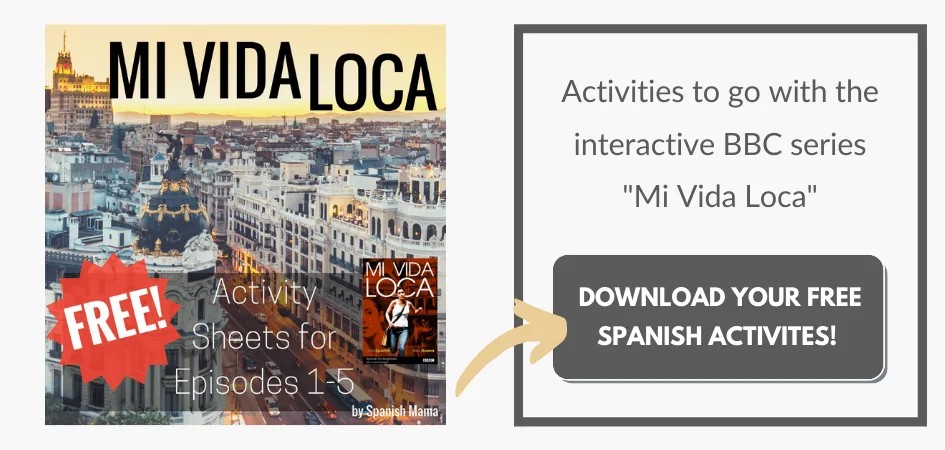Every year, the beginning of the school year feels like a whirlwind. As educators, we’re juggling a million things at once, from making students feel welcome to establishing classroom routines and ensuring engagement from day one. It’s a demanding period, and having a solid plan can make all the difference. To help you navigate those crucial first weeks of Spanish class, we’ve put together a comprehensive study guide, focusing on the essential “Unit 0 – Para Empezar” concepts that lay the groundwork for Spanish Two success.
This guide draws inspiration from effective strategies for launching a proficiency-based and comprehensible input-driven Spanish classroom. The core idea is to prioritize high-frequency structures right from the start, setting clear expectations and creating a welcoming environment where students feel comfortable taking risks and engaging with the Spanish language.
This approach shifts the focus from rote memorization to meaningful communication. Instead of drilling grammar rules in isolation, we aim to immerse students in the language through engaging activities, stories, and authentic resources. This “Unit 0 – Para Empezar” period isn’t just about covering basic vocabulary; it’s about building a foundation for genuine language acquisition that will serve students well as they progress into Spanish Two and beyond.
Grading, Procedures, and Syllabus: Setting the Stage
One of the first steps in establishing a successful Spanish classroom is rethinking traditional grading categories. Moving away from a system heavily reliant on tests and quizzes, a proficiency-based approach emphasizes the five key skills: reading, writing, listening, speaking, and work habits. This framework, inspired by educators like Martina Bex, provides a more holistic view of student progress.
Instead of focusing on memorization and isolated grammar points, proficiency-based grading assesses how students can use the Spanish language in meaningful contexts. The syllabus becomes a roadmap that outlines not just the rules and procedures, but also the why and how of learning Spanish. It communicates the classroom’s commitment to developing real-world communication skills, aiming for a Novice-Mid proficiency level by the end of Spanish One, which serves as a strong starting point for Spanish Two.
Key elements of the syllabus include:
- Proficiency-Based Categories: Reading, writing, listening, speaking, and work habits become the core assessment areas.
- Emphasis on Input: The curriculum prioritizes engaging input through stories, music, and readings, rather than just textbook exercises.
- Authentic Assessment: Assessments focus on students’ ability to use internalized language to communicate, rather than recall memorized phrases.
(Syllabus Image from Original Article would be inserted here)
This image displays a sample Spanish class syllabus projected for parents, outlining key aspects like ‘Eyes and Ears,’ ‘Can-Do’ statements, and course expectations.
Interactive notebooks also play a crucial role in organizing student learning. These notebooks become a central repository for bell-ringers, written input materials like stories and song lyrics, and focused grammar notes introduced later in the year.
Unit 1: Our Classroom & Nuevos Amigos – Para Empezar in Action
“Unit 1: Our Classroom & Nuevos Amigos” serves as the practical application of “Para Empezar.” This unit is designed to answer essential questions that resonate with beginning language learners:
- Who is in our learning community?
- Who am I within this community?
- Why are we learning Spanish?
- How can I effectively communicate my needs in the target language within the classroom setting?
The macro targets for this unit are clearly defined and action-oriented:
- Greeting and introducing oneself and others.
- Requesting materials and information in Spanish.
- Understanding the purpose and expectations of the Spanish class.
The language focus for this unit is deliberately practical and high-frequency, including greetings, introductions, classroom object vocabulary, and foundational verbs like tener (to have), ser (to be), hay (there is/are), numbers, decir (to say), and gustar (to like).
First Two Weeks: Day-by-Day Breakdown – Your Para Empezar Study Guide
This detailed day-by-day plan provides a structured approach to implementing “Unit 0 – Para Empezar” in your Spanish classroom during the first two weeks. Remember to incorporate brain breaks as needed, using resources like “Puedo Ir al Baño” or “Mano Nerviosa,” to maintain student engagement and energy levels.
Day 1: Names and Classroom Community
- Focus: Learning names and establishing a welcoming classroom environment.
- Activities:
- “Bienvenidos” greeting with Spanish songs playing as students enter.
- Name tag creation activity combined with drawings to personalize learning space.
- “Circling with Balls” activity to introduce ¿Cómo te llamas?, me llamo, and se llama in a dynamic, interactive way.
- Classroom rule introduction integrated naturally within activities, emphasizing TL use, active listening (“eyes and ears”), and a caring classroom culture.
- Bracket voting icebreaker to gauge student interests and preferences using simple questions like ¿Leer o Netflix?
Day 2: Getting to Know Each Other
- Focus: Expanding on name recognition and introducing descriptive vocabulary.
- Activities:
- “Para Empezar” seating arrangement using name cards from Day 1.
- Input activity using pre-written statements about students, incorporating cognates and projecting them for class to see.
- Introduction of hay, chico, chica, and le gusta with visuals and contextual examples.
- Descriptive guessing game using hay, chico/chica, and le gusta to describe students.
- Optional: Señor Wooly’s “Puedo ir al baño” video as a closing activity.
Day 3: Course Expectations and Interactive Notebooks
- Focus: Clarifying course expectations, grading, and proficiency levels, and setting up interactive notebooks.
- Activities:
- Discussion on ACTFL proficiency statements to help students understand language learning levels.
- Brief review of ACTFL standards and distribution of grading rubrics to illustrate assessment methods.
- Explanation of grading scheme emphasizing engagement and understanding over rote memorization.
- Interactive notebook assembly – a time-saving investment for the year, incorporating resources like “Puedo ir al baño” and “Tengo tu love” songs during setup.
Day 4: Classroom Objects and Basic Needs
- Focus: Introducing classroom object vocabulary and expressing possession.
- Activities:
- “Para Empezar” activity: Copying classroom object terms into interactive notebooks.
- Introduction of tienes and tengo using the song “Tengo tu love” (focusing on relevant sections).
- Interactive games and activities to practice classroom object vocabulary and tengo/tienes: “Yo tengo, ¿quién tiene?”, “Tienes/No tengo” card games, Slap-it, Flyswatter, Go Fish (adjusting complexity based on student level).
Day 5: Review and Storytelling
- Focus: Reviewing phrases from Days 1-4 and engaging in initial storytelling.
- Activities:
- Review games to reinforce vocabulary and phrases learned.
- Storyasking activity using phrases from Days 1-4, centered around a student unprepared for class, incorporating props and student actors for engagement.
- Story outline example provided (as in original article) incorporating dice, se llama, tener, and classroom objects.
Day 6: Dice Unit and First Readings
- Focus: Introducing the Dice unit and incorporating first readings.
- Activities:
- Input: Distribute typed story from Day 5 with comprehension questions in English.
- “Para Empezar”: Martina Bex’s Dice unit slideshow (p. 5 or 6) for bell-ringer activity in interactive notebooks.
- Introduction to “Los pollitos dicen” song using Dice unit elements (Days 1 and 2).
- Brain break: Classroom object review games (stand and touch, Slap-it).
- Storyasking activity: Introducing éste/ésta es, un muchacho/a, and dice using flip-flaps in notebooks.
- Closing: Dice unit slides (5, 6, or 7).
Day 7: Short Story Comprehension
- Focus: Reading and understanding a short story and continuing Dice unit activities.
- Activities:
- “Para Empezar”: Dice unit slides (8 or 9).
- Input & storyasking: Dice unit storyasking (p. 19), building on week one structures.
- Brain break: Classroom object games or Spanish song.
- Closing: Dice review with Dice unit p. 20.
Day 8: Traditional Songs and Embedded Readings
- Focus: Singing a traditional song chorus and using embedded readings.
- Activities:
- Input: “Me llamo” embedded readings from Martina Bex’s resources.
- Interpretive Listening: “Los pollitos dicen” song activity using provided activity sheet.
- Brain break: Classroom object games or Spanish song.
Day 9: Numbers Introduction
- Focus: Introducing numbers 1-10 and practicing name recall.
- Activities:
- “Para Empezar”: Dice unit slide 11.
- Input: “Me llamo” readings continued.
- Game: “Mano Nerviosa” counting game to practice numbers 1-10, after writing number words in notebooks.
- Brain break: Classroom objects games.
Day 10: Review and Formative Assessment
- Focus: Reviewing key concepts and conducting a formative freewrite assessment.
- Activities:
- Assessment: 5-10 minute freewrite formative assessment, asking students to tell a story without aids.
- Discussion: Reflecting on “why we’re learning Spanish,” shifting from pragmatic reasons to empathy, compassion, and global citizenship.
- Brain break: Mano nerviosa.
(Image of PreK-Elementary Spanish Unit from Original Article would be inserted here)
This image showcases a sample unit plan visually, likely for younger Spanish learners, illustrating a thematic approach to language learning.
These first two weeks, grounded in “Unit 0 – Para Empezar,” are crucial for setting the tone for the rest of the Spanish learning journey. By focusing on creating a communicative, engaging, and proficiency-oriented classroom, you’re not just teaching Spanish; you’re building a foundation for lifelong language learning and cultural understanding, perfectly setting the stage for success in Spanish Two.
Unit 2: My Immediate World and Who I Am (Building on Para Empezar)
Moving beyond “Para Empezar,” Unit 2 expands on the foundational concepts, delving into personal descriptions and preferences. The essential questions for this unit become:
- What are my personal characteristics?
- What activities do I enjoy?
- What are the interests of others in our class?
Macro targets for Unit 2 include:
- Describing oneself and personal preferences.
- Describing classmates and their preferences.
- Discussing daily activities and plans.
Assessment in Unit 2 often includes quizzes based on “La persona especial” interviews, encouraging interpersonal communication. Language structures expand to include sports, hobbies, voy a/vas a/va a (going to + infinitive), adjectives, estoy/estás/está (I am/you are/he/she is – feelings/temporary states), le gusta/me gusta/te gusta, and articles.
(Image of Back to Spanish Class Lesson Plans Pin from Original Article would be inserted here)
This Pinterest-style image promotes Spanish class lesson plans, likely intended for teachers seeking back-to-school resources.
By thoughtfully planning and implementing “Unit 0 – Para Empezar” and the subsequent units, you can create a dynamic and effective Spanish learning experience that empowers students to confidently progress through Spanish Two and beyond.

